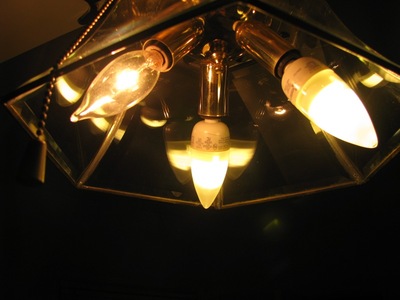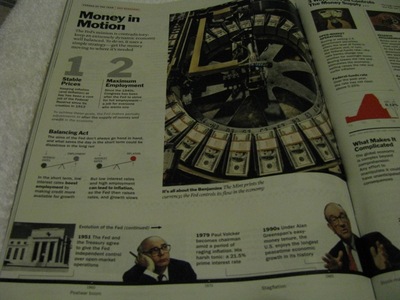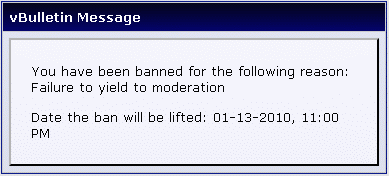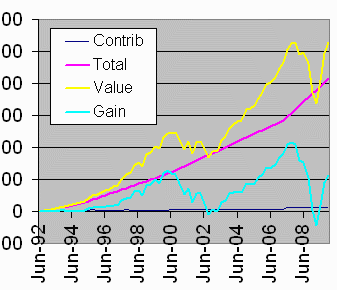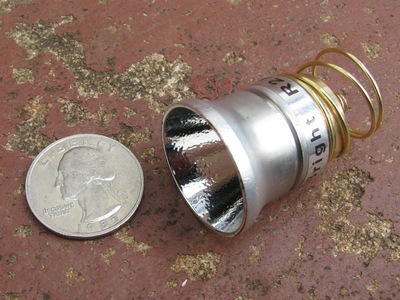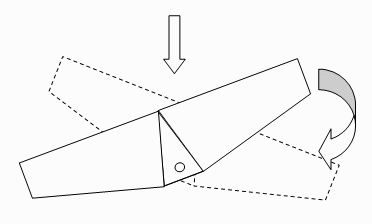Ultrafire WF-504B with XR-E R2 Drop-in Review
I was interested in getting a flashlight that could accept P60 drop-ins. After reading Don's review at jayki.com it seemed like the 504B (from DealExtreme) would be a good choice for a host because he felt like the heat-sinking was good and he liked the button. It looks good too and it is able to tailstand. I figured since the anodizing on these is Type II instead of the more durable Type III that I would be better off with the natural aluminum version because it wouldn't show if any of the finish flaked or wore off. I liked the shiny finish in the pictures (looked like stainless steel) more than the shiny black finish (it seems like black should be more of a matte finish than glossy).
I recently got another light in a natural silvery finish like that, but it turned out more matte and had a greenish tint. When I opened this light, there was no matte and no green tint: it was shiny like stainless or chrome (dare I say maybe even kind of like titanium?). I don't know how long it will stay that way since aluminum is more susceptible to scratches than stainless. With the big anti-roll hex head, it looks a little like it is made of plumbing fixtures (in a good way). The knurling looks good with a heavier texture on the body than knurling on the tail piece. The light is more compact than I thought, just a little fatter than a Mini Maglite (the minimag in the picture has a pewter finish so it is a little darker), but also just a little too big to put in a pants pocket. The only bad thing about the design is the inner bezel over the lens which I guess might be stainless is only inside of the rest of the head, so it doesn't protect the outer aluminum bezel from scratches and it already has a few dings around that edge. If it extended all the way to the outer part of the light it would offer a lot better protection.
Build Quality
I am very impressed. The threads are very smooth and the o-rings seem to work with a nice thick black one at the head and a skimpier one in the tail. Both seem to engage properly and should offer pretty good water resistance. There was some clear gunk on the tail threads that may be some kind of thick grease though it didn't seem slippery (maybe thread compound?). There was some oily grime on the inside of the lens which I was able to remove with a couple of applications of Windex (though I couldn't figure out how to remove the lens itself; I couldn't budge the inner bezel). There are a couple of little dings or machining marks in the exterior, but overall I really like the finish and detailing. Some of the tail threads look like they weren't formed all the way, but this is not a visible area and doesn't seem to affect anything.
The tail switch is black rubber which I think goes great with the silver finish. It has a very solid feel when clicking, but isn't hard to click. There are two lanyard holes so that the lanyard can be put on without affecting its ability to tailstand.
The drop-in fits fairly loosely in place and I didn't notice a lot of heat coming through. I wrapped the sides of the drop-in with some heavy duty aluminum foil folded several times and smoothed out as best I could in order to make it fit more snugly. I don't know if this helps or not. The XR-E LED probably doesn't get as hot as some brighter drop-ins.
Because this is a P60 host and drop-in, the drop-in probably needs to be reviewed as a separate entity. I've never had one of these, so I can't say anything about how it compares to others. It is an offbrand Super Bright R2 module (labelled that way at least). The LED is definitely a XR-E, but I can't tell what bin. There were a couple of tiny specks on the LED dome that I was not able to remove. I couldn't even see them without a magnifying lens. The reflector is aluminum with a mild orange peel. It has some spill and a pretty tight hotspot that throws quite well. The tint is definitely cool white, maybe a little violet.
The current runs high on a fresh protected gray 2400mAh Trustfire 18650 lithium ion battery, 1.1 Amps, but drops off quickly to 0.83A at 3.95V then declines steadily to 0.70A at 3.8V and 0.50A at 3.6V. I can't measure brightness, but there can't be a whole lot of regulation involved. On a battery charged to 4.2V, the light lasts about 90 minutes before getting down to 3.6V.
| Time | Amps | Volts |
|---|---|---|
| 0:00 | 1.08 | 4.19 |
| 0:15 | 1.00 | 4.00 |
| 0:30 | 0.86 | 3.90 |
| 0:45 | 0.74 | 3.81 |
| 1:00 | 0.65 | 3.73 |
| 1:15 | 0.56 | 3.68 |
| 1:30 | 0.50 | 3.63 |
| 1:45 | 0.46 | 3.59 |
Repeating the test with a similar protected gray 2400mAh Ultrafire 18650, I got 15 additional minutes, for some reason not registering the high initial current draw from before:
| Time | Amps | Volts |
|---|---|---|
| 0:00 | 0.90 | 4.17 |
| 0:15 | 0.99 | 4.00 |
| 0:30 | 0.87 | 3.95 |
| 0:45 | 0.81 | 3.89 |
| 1:00 | 0.78 | 3.85 |
| 1:15 | 0.70 | 3.79 |
| 1:30 | 0.62 | 3.73 |
| 1:45 | 0.53 | 3.66 |
| 2:00 | 0.46 | 3.59 |
Indoor Beam Shots
The 504B is always on the left and the lights are 50cm from the wall. ISO is 100 and aperture is f2.8.
On high vs. Fenix L2D Q5 with shutter speed of 1/25 second. The Fenix is powered by 2 freshly charged AA NiMH Eneloops and is on Turbo mode (180 lumens). The Fenix has a yellowish tint while the 502B is fairly cool:
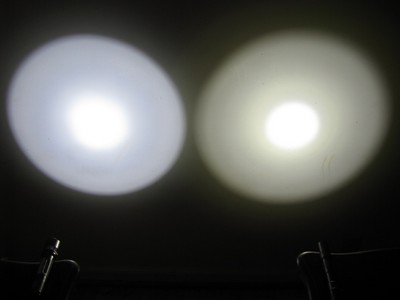
Shutter speed dropped to 1/100 second:
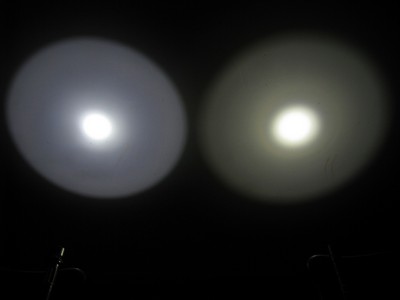
Shutter now at 1/1600 second. The 504B has a more intense hotspot:
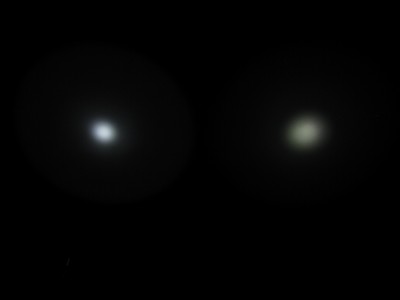
I recently got a Uniquefire S10 6-mode from KaiDomain, but I burned the driver out using a lithium-ion 14500. So I converted it to direct drive with a 14500 only. This light has the same LED, a Cree XR-E R2. The tints of these two are pretty similar. At 1/25:

Shutter speed dropped to 1/100 second:
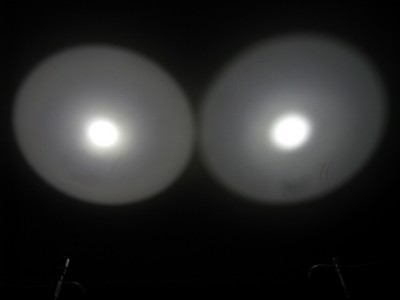
Shutter now at 1/1600 second. The 504B again has a more intense hotspot:
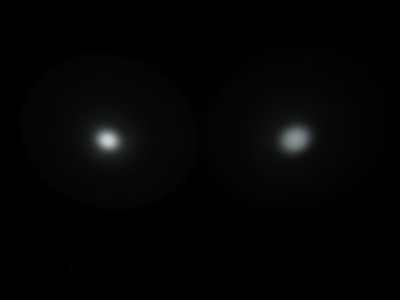
Outdoor beam shots
The forked stick in the ground is 25' away. To the left of that stick are two fence posts where the hotspot is focused. These are 120' away. The shutter is left open for 4 seconds to get a picture that looks about what you see. Here is a control shot:

For comparison sake, here is a beam shot of the Fenix L2D on turbo:

And here is the Uniquefire S10 directly driven by a 14500:
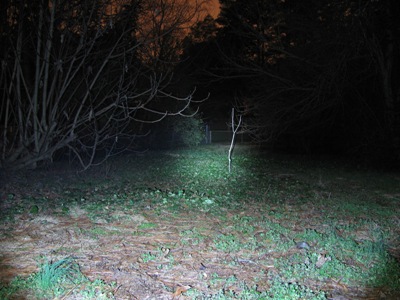
Now the Ultrafire WF-504B on high. It has better throw and the fence posts are better defined:

With the battery run down to 3.6V, the beam isn't nearly as bright:
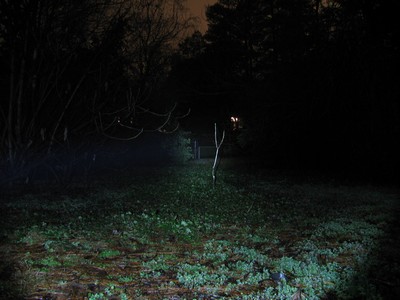
Back on a fresh battery, the 504B on medium:

Conclusion
I am very impressed by the quality of this $14.99 light and I really like the shiny aluminum finish. The design is excellent (it should be since it is a knockoff of the Surefire 6P and Solarforce L2) but everything seems like is very good quality for a DealExtreme light. The drop-in seems a little weak, not offering memory mode and with poor regulation, but the brightness is good and it throws better than any of my smaller lights. I can always change the driver or the whole drop-in.
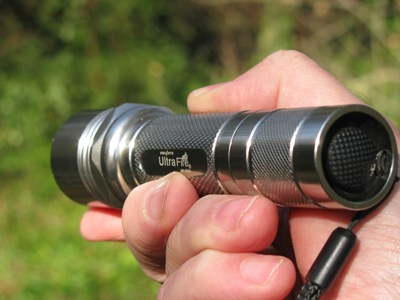
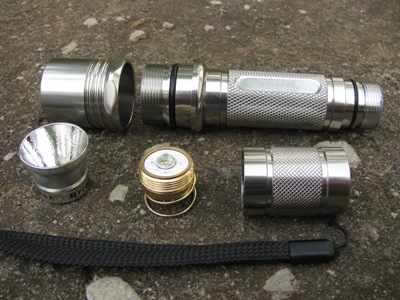
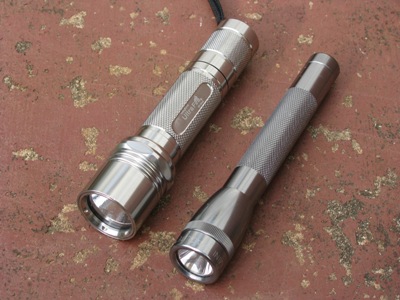

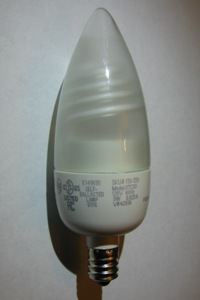 The fan has candelabra bulbs in it that burn out all the time, so it would be nice if I could find something that wouldn't burn out and would be more energy efficient. These have a kind of chubby shape to them and you can see a skinny helix inside the bulb despite the frosted glass that covers it. They're certainly not as attractive. But they were also only $1 each. So I bought three of them. They are made with the narrow base that my light fixture uses, but they come with adapters so they can be screwed into a regular base. One of them has some flicker to it, so I will take that one back.
The fan has candelabra bulbs in it that burn out all the time, so it would be nice if I could find something that wouldn't burn out and would be more energy efficient. These have a kind of chubby shape to them and you can see a skinny helix inside the bulb despite the frosted glass that covers it. They're certainly not as attractive. But they were also only $1 each. So I bought three of them. They are made with the narrow base that my light fixture uses, but they come with adapters so they can be screwed into a regular base. One of them has some flicker to it, so I will take that one back.